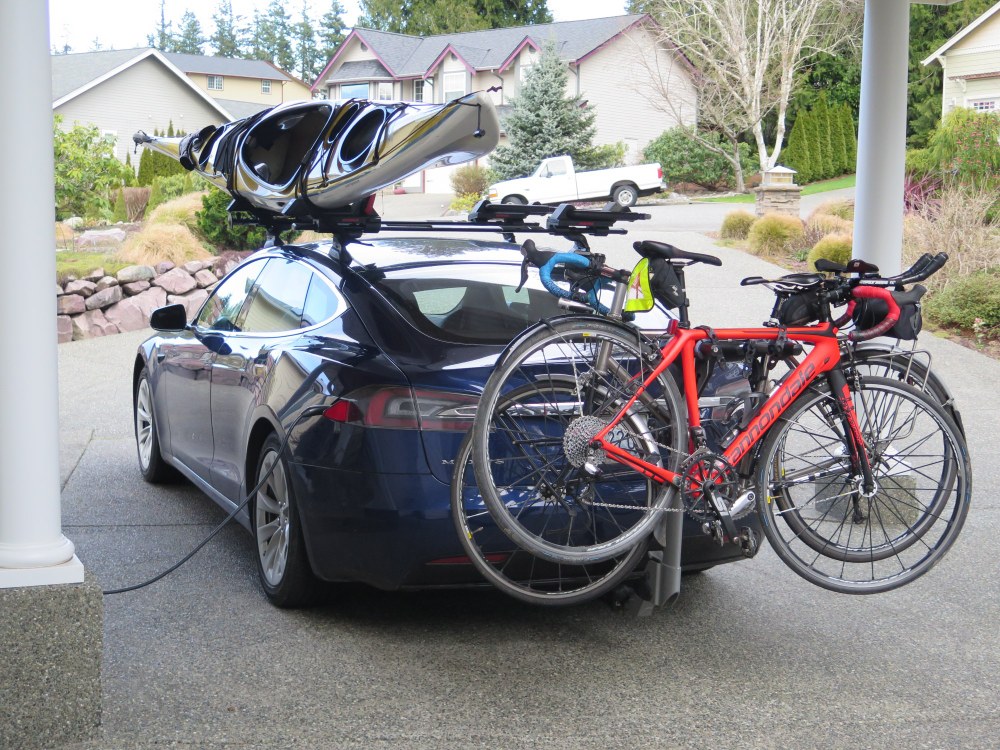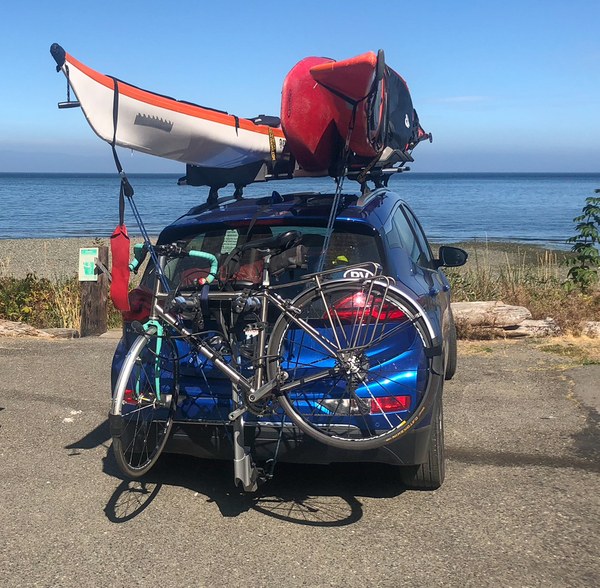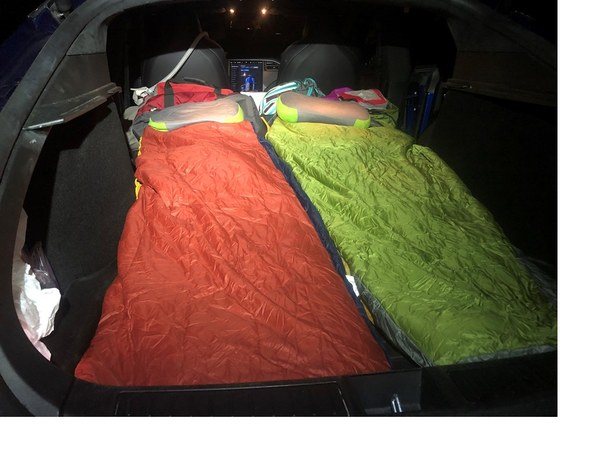
The Mountaineers made a commitment to reduce our organization’s carbon footprint as part of Vision 2022. In the Carbon Footprint Reduction Committee’s last blog post, we discussed transportation and a few ways you can reduce your carbon footprint. In this blog, we dive deeper into electric vehicles (EVs).
Why would a Mountaineers member be interested in an electric vehicle? I used to view EVs as “good for the planet,” but also expensive and limited in how far they can go. However, after serving on this committee, I’ve learned that these potential barriers aren’t as concerning as I once thought. More importantly, EVs offer benefits to an outdoor adventurer like myself that gas cars can’t deliver.
Decrease your carbon footprint
There are many benefits to an EV, whether you head to the mountains every weekend or not. The most obvious is that they don’t emit carbon dioxide into the air every time we leave our homes. Even including the manufacturing process, EVs emit less carbon into the air over their lifecycle than many of their gas-powered rivals. And then there’s the cost. While they tend to have a higher upfront price tag, you never have to buy gas or change the oil. Maintenance is also drastically reduced when you move from a gas-powered car that has roughly 2,000 moving parts to an EV, which has around 20. To better illustrate the cost and emissions of different types of vehicles, a Massachusetts Institute of Technology (MIT) lab recently created this helpful chart. You can even customize it to your state, electric rates, and fuel prices.
Don’t miss out on range
Believe it or not, you can go just about anywhere in the lower 48 in an EV. Most current EVs have a range of 100-350 miles, and they’re only getting better. Apps like PlugShare will show you every charging station in the country so you can plan your trip, and the network of charging stations is also constantly improving. There is really no trailhead, river, or dock you can’t get to in the Northwest with an EV. As Jessica Plumb said in her 2018 Mountaineer magazine article, “if you can climb up, you can get down,” because you’re charging with regenerative braking on the way down the mountain.
 Adventure electric vehicle loaded up for a multisport day. photo courtesy of charlie michel.
Adventure electric vehicle loaded up for a multisport day. photo courtesy of charlie michel.
Camp in comfort
That oversized battery on wheels can do a lot for you while camping. With electronic devices like phones, GPS units, rescue and communications devices, and cameras so prominent in our modern-day adventures, an EV provides a way to charge them all in remote areas without running the car.
But what excites me the most is that the battery can also power the heater or A/C on some models without the car idling. Imagine coming back from a cold, wet kayaking trip on the Olympic Peninsula or a sweaty hike in Eastern Washington with a 90 degree night ahead of you. If you have sufficient charge on your battery, or are near a power source (a campground, RV park, or ranger station), simply throw down the seats and sleep comfortably in your climate-controlled car. Depending on how many electronic gadgets you’re charging, this uses 20-40 miles of range. If you’re plugged into an external power source, not only do you sleep in comfort but you wake up with a full tank of electrons.
 Committee member charlie michel is all set for a cozy night of sleep in his electric vehicle.
Committee member charlie michel is all set for a cozy night of sleep in his electric vehicle.
Gear storage and AWD on steroids
The battery of an EV is not the only advantage. By moving away from engines, fuel tanks, exhaust systems, transmissions, drivetrains, and cooling systems, EVs can come up with creative ways to use that space. Internal components can be shifted around to open pockets of storage that gas-powered cars can’t deliver. There’s the example of Tesla’s “frunk,” or Rivian’s “gear tunnel.”
Some EVs also have benefits in slippery or tight environments. Some vehicles come with two, or even three electric motors, allowing front and rear wheels to operate independently as needed by the environment. It’s like AWD on steroids. GMC’s electric Hummer can move diagonally - imagine being able to maneuver to that perfect campsite between the trees that you couldn’t reach before.
While these capabilities are exciting, what intrigues me is that we’re at just the beginning of the EV revolution. Battery recycling is also making a monumental shift, with companies reusing EV batteries for second life applications, and other companies finding efficient ways to recoup the precious metals for future manufacturing. I can’t wait to see what designers come up with in the next few years as they (and we) begin to break free from the traditional thinking behind what a car is and does. And with more competition, hopefully that brings more competitive pricing.
Tips and tricks
Considering making the switch? Here are a few tips from Mountaineers EV owners on things to look out for:
- When looking for charging stations, look at what’s around them. You might stumble upon a new restaurant, park, or cafe you’ve never been to.
- Pay attention to the DC fast-charging capabilities of the models you’re interested in. The more kilowatts (kW), the faster you’ll be able to charge.
- Having different charge adapters for different outlet types opens up even more possibilities at places like motels, campgrounds, friends’ homes, etc.
- If the initial price is still too high for your budget, take a look at used vehicles. There are technicians in the Puget Sound region who will test batteries for you. I’ve even seen a couple Chevy Bolts on Craigslist with active, transferable warranties.
- Give it some time. If you don’t see the model you’re looking for, it will likely arrive in the next couple of years. Trucks and vans are on their way.
Interested in learning more? Check out committee members Charlie Michel and Jim Burke’s webinar on EVs.
Main image of an electric vehicle charging up for an adventure. photo courtesy of charlie michel.
Add a comment
Log in to add comments.MIT chart informative, thank you!
 Nate Brown
Nate Brown